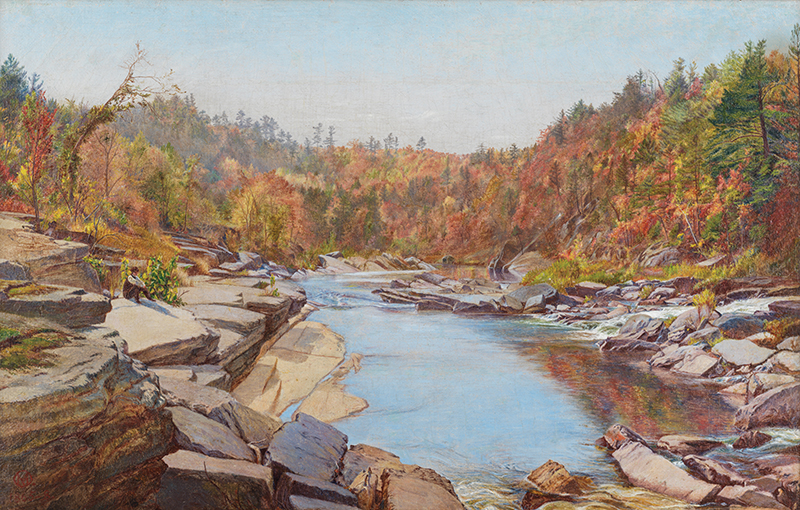
John Ruskin dedicated the first volume of Modern Painters (1843) “To the Landscape Artists of England.” The eminent Victorian critic’s argument, in what grew to be a five-volume series, urged contemporary artists to embrace modernity by casting off the picturesque traditions advocated in the academy and committing themselves to drawing and painting out of doors directly from nature: “rejecting nothing, selecting nothing, and scorning nothing.”1 In 1848, Ruskin’s call inspired British artists John Everett Millais, William Holman Hunt, and Dante Gabriel Rossetti to found the English Pre-Raphaelite Brotherhood. The name announced a return to the simplicity and sincerity they found in early Italian art before Raphael.
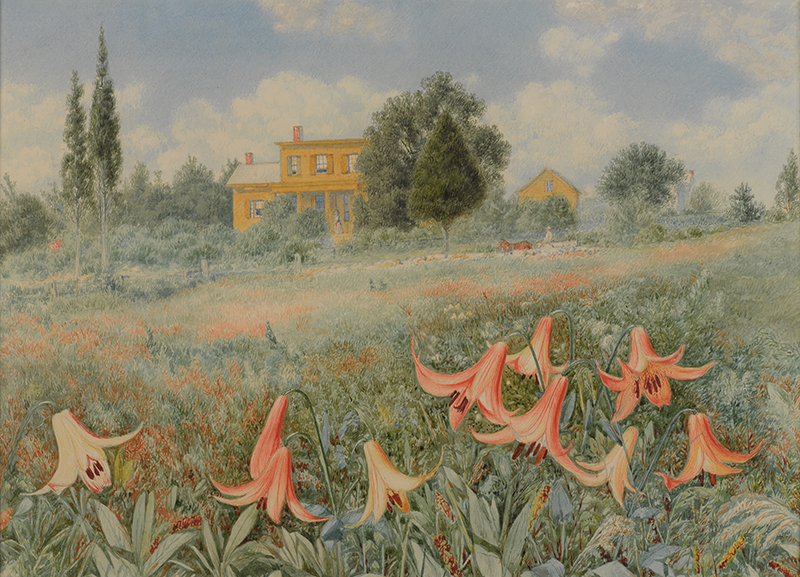
The landscape artists of America were also receptive to the messages of Modern Painters. American critic, artist, and photographer William James Stillman recalled in 1860 that the first volume had been a best-selling “sensation,” received like divine revelation as a “thunderbolt from the clear sky.”2 The volumes that followed were all widely read in the United States. States. In 1855, Clarence Cook, American critic and future editor of the American Pre-Raphaelites’ crusading art magazine, the New Path, testified to the power of Ruskin’s eloquent prose. “We love Ruskin’s glowing style,” he wrote, “we love his love of nature, we love his love of God. He carries us along with him by his enthusiasm.”3 We see the impact of Ruskin’s mandate for dedicated truth to nature in veteran landscapist Asher B. Durand’s intensified practice of plein-air painting in the 1840s. Modern Painters also inspired younger painters like Frederic Edwin Church, who, though Thomas Cole’s brilliant pupil, followed Ruskin’s call (and Alexander Humboldt’s) in his early masterpieces: Niagara (1857) and Heart of the Andes (1859).

In 1863, twenty years after the first volume of Modern Painters had been published, and during the tumultuous years of the Civil War, a militant, albeit brief, manifestation of Ruskin’s cultural authority in America was organized with the founding of the Association for the Advancement of Truth in Art in New York. Although the first meeting was held in the studio of English expatriate artist and Ruskin pupil Thomas Charles Farrer, artists were not alone among the founding members. They were joined by architects, critics, journalists, scientists, and others. The group’s mission was nothing less than the Ruskinian reform of American art, architecture, criticism, manufacture, and design (as well as supporting the Union cause).4 A few months after its founding, the association launched the New Path, its radical journal (“baptized ‘The New Wrath’ by its enemies”).5 Cook, already a seasoned Ruskinian critic, served as the publication’s dominant voice, roundly chastising mainstream artists like Cole and even Durand while exhorting the faithful to ever more strenuous efforts in service to Ruskin’s Truth to Nature.

Soon after their affiliation with the association, the artist members were dubbed the American Pre-Raphaelites. Their regimen was demanding. Of the horticultural world, Ruskin had decreed: “Every herb and flower of the field has its specific, distinct, and perfect beauty; it has its peculiar habitation, expression and function.” Regarding terrestrial and atmospheric features, the English critic demanded of artists: “Every class of rock, every kind of earth, every form of cloud, must be studied with equal industry, and rendered with equal precision.”6 An outdoor study might take weeks, if not months of an artist’s time and labor. Charles Herbert Moore responded strongly to Ruskin’s commands, even recording on the canvas beneath his signature the four-year effort required to complete his small but remarkable Autumn Landscape (Fig. 1). Describing his painstaking process to Farrer, he reported, “I cover about as much canvass as I could cover with the end of my thumb in a forenoon of three hours work.”7

By hewing so closely to Ruskin’s mandate in portraying the natural world, the American Pre-Raphaelites created paintings in both oil and watercolor that were insistently distinct from mainstream landscape production—obsessively detailed and vivid in color. Works like Moore’s Autumn Landscape with its brilliant light and sharply defined details were praised by the partisan critics of the New Path as vibrant agents of modernism. But more conservative critics saw them as too “hard and harsh and real.”8 Nevertheless both camps acknowledged the visual shock delivered by such radical works. On July 12, 1867, the New Haven Daily Palladium declared, “They will NOT be passed by.”

This fascinating body of work is revisited in the current exhibition The American Pre-Raphaelites: Radical Realists. While few of the member artists are well known today, the exhibition and accompanying publication make the claim that their works reward study and that their legacy merits reconsideration. They include Moore, Farrer, John William Hill, his son John Henry Hill, Henry Roderick Newman, Robert J. Pattison, and William Trost Richards; Fidelia Bridges is today the best-known, woman artist in Ruskinian circles, although far from the only one. Most of the artists were in their twenties and early thirties. With the exception of Farrer, they first came to Ruskin’s ideas via his publications. Their beliefs drew them into the informal Ruskinian networks of New York, Boston/Cambridge, and Philadelphia. Some members had seen models of early Pre-Raphaelite realism in an important exhibition of English art shown in those cities in 1857 and 1858.9
Farrer, who had studied drawing with Ruskin and Rossetti at the Working Men’s College in London, arrived in New York late in 1858. He was remembered by one journalist and collector as a missionary who was “of unfailing aggressiveness” on behalf of Ruskin’s ideas.10 Befriended early on by the Hills, Farrer would recruit both father and son for the Association for the Advancement of Truth in Art. Farrer was likely encouraged by them to undertake plein-air painting at their homestead in Rockland County. Perhaps it was in their meadow that the young artist found the subject for his exquisite June (Fig. 4), painted in 1867. There, we are deep among wild lilies, red clover, and foxtail grass with a blue summer sky above. Farrer’s “living” still life, a favorite American Pre-Raphaelite motif (rather than the traditional nature morte), offers a visual paraphrase of Ruskin’s observation that “every herb and flower of the field has its specific, distinct, and perfect beauty.” The original gilded frame bears lines of verse celebrating the summer season by American poet James Russell Lowell, thus unifying the visual and literary arts.
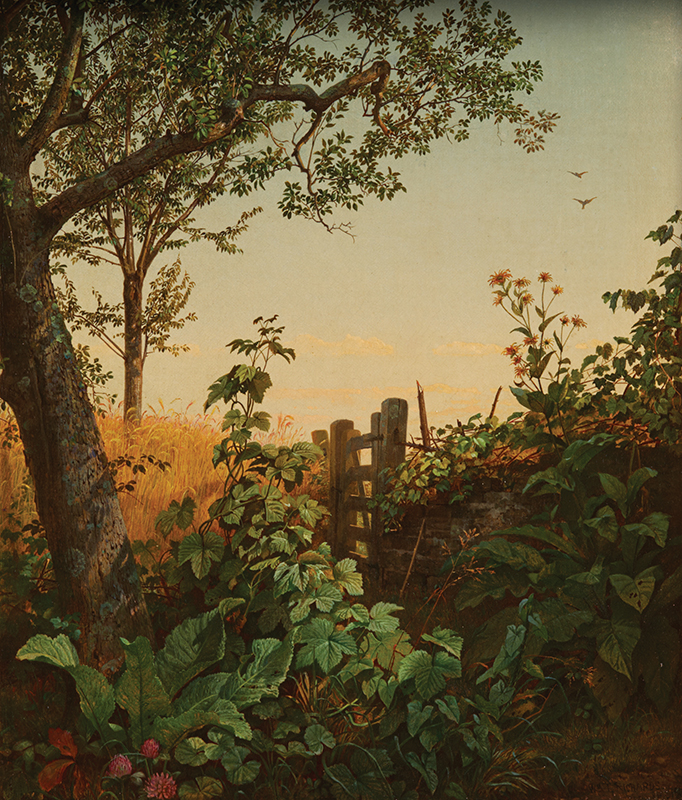
Both Hills also embraced the motif of the living still life, working primarily in watercolor, a medium Ruskin endorsed in his popular manual, The Elementsof Drawing (1857). Adopted as the signature medium of the American Pre-Raphaelites, watercolor was increasingly popular among other artists as well. John William Hill was already a successful topographical watercolorist in the long-established Anglo-American tradition. In the mid-1850s he reinvented himself as a Ruskinian realist after reading Modern Painters and mastering a miniaturist’s delicate stipple and hatching technique. His splendid West Nyack, New York (The Lilies of the Field) (Fig. 2) of 1868 pays homage to the Hill property in Rockland County that had been home to three generations of artists. Their studio building appears to the right of the family homestead and a field of festive wild lilies dominates the entire foreground. The alternate title, The Lilies of the Field, a biblical reference from the Sermon on the Mount, makes explicit the work’s spiritual resonance, celebrating, like Lowell’s poem, the beauty to be found in humble surroundings.
John Henry Hill, a lifetime student of his father and Ruskin, delighted in portraying the American fringed gentian in oil and watercolor (Fig. 10). This elusive wildflower that bloomed late in the year inspired poets as well, including William Cullen Bryant and Emily Dickinson.11 Clarence Cook’s sonnet “To the Fringed Gentian” was published in the New Path. Henry Roderick Newman’s astonishingly particularized depiction of the flower is now known only as a chromolithograph published after his painting of about 1868. He maps the gentian’s natural habitat of forest floor—dead leaves and peeling bark—in sharp contrast to the brilliant blossoms and maidenhair ferns. One critic responded to the mystical power of this hyperreal image by pronouncing Newman’s saga of living beauty emerging amid decay to be a “sermon.”12 Newman was thelast artist member to be elected to the Association for the Advancement of Truth in Art. The promising young Pre-Raphaelite left the United States in 1870 for a healthier climate, ultimately settling in Florence, where he would remain faithful to Ruskinian practice. His large and lush tapestry-like landscapes of Tuscan wildflowers, such as the vibrant Anemones and Daffodils (Fig. 5), were collected by Americans on the grand tour as well as by Ruskin himself.

William Trost Richards wasa young Hudson River school painter based in Philadelphia when he was galvanized around 1858, perhaps by the study of paintings in the exhibition of English art then traveling the country, to embrace Ruskinian practices. The botanically correct title of his small watercolor Red Clover with Butter-and-Eggs, and Ground Ivy (Fig. 6) signals this conversion. Farrer enlisted him to the cause, and for a decade Richards would be best known among American Pre-Raphaelites for meticulously realized forest interiors and all-foreground landscapes. These works were sometimes enriched with biblical or political narratives hinted at in titles such as A Neglected Corner of the Wheatfield (Fig. 7). These “miracles of special study”13 (as one critic called them) are filled with horticultural and agricultural symbolism.Neglected Corner presents a mob of unruly weeds threatening to invade orderly rows of grain growing nearby. Such a scenario would have had political overtones for a Union audience in 1865.
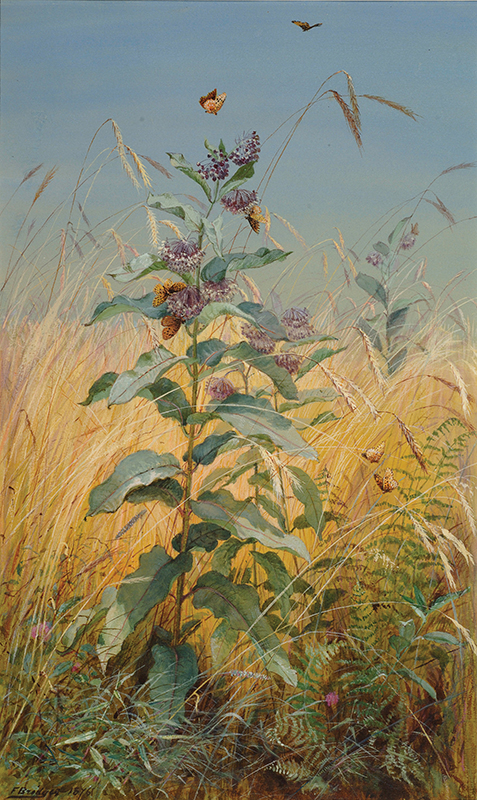
Richards would mentor Fidelia Bridges in the 1860s; indeed, all the association’s artist members tutored others. Some like Robert J. Pattison and Moore devoted decades to teaching drawing. Bridges employed the all-foreground format during a long and successful career as a watercolor specialist documenting plants in their natural environments. Characteristically, she favored depictions of wildflowers and even weeds. Her exuberant Milkweeds (Fig. 9) flourish in the midst of a wheat field as a lighthearted reprise of Richards’s wartime allegory of good and bad governance.
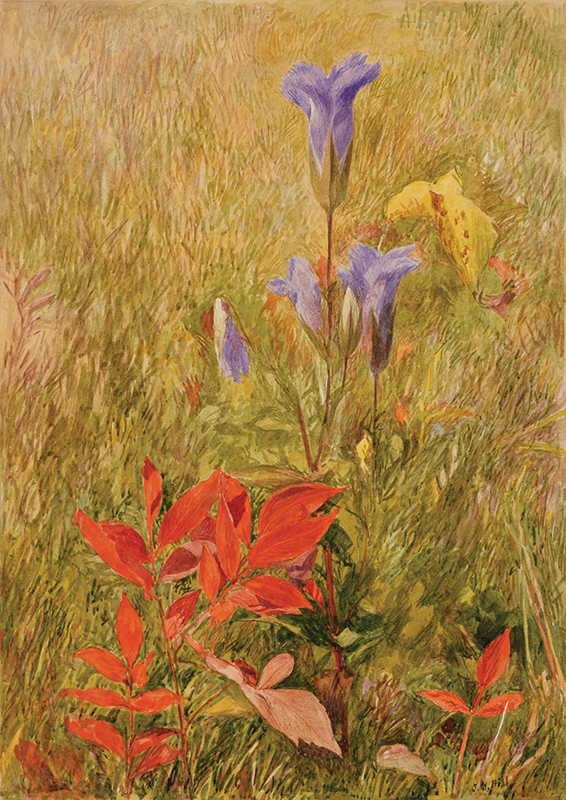
Strict attention to geological as well as horticultural detail was also a central concern of the radical realists. In a large and dramatic recently discovered watercolor, Pattisontakes on what was perhaps Ruskin’s most revered terrestrial feature (Fig. 8). “Mountains,” the critic (and dedicated gentleman geologist) declared, are the “great cathedrals of the earth.”14 The site has not been identified but is likely to be a view in the White Mountains of New Hampshire, where Pattison sketched and painted in the 1860s. He boldly maps an expansive vista of the undulating mountain range under alternating bands of sunlight and shadow. From sheep sheltering beneath the ledges in the foreground, the eye soars across a cultivated valley to distant peaks beyond. Professional geologists were, in fact, among the association’s founding members. In 1868 John Henry Hill served as staff artist on the US Geological Exploration of the Fortieth Parallel led by former fellow member Clarence King. Hill’s continuing attention to geological formations is evident in his large watercolor Natural Bridge, Virginia (Fig. 13). He was undoubtedly drawn to this site less for its picturesque appeal than by his fascination with geological processes such as the erosive power of water and wind.
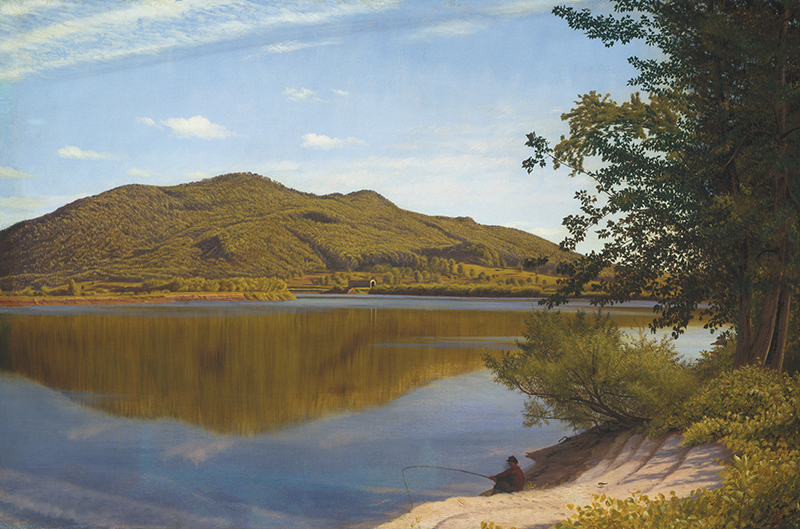
Charles Herbert Moore’s works also resonate powerfully with Ruskin’s exhortations to know “every class of rock, every kind of earth, every form of cloud.” Moore’s series of extraordinary geological studies includes the precisely painted river shoreline in Hudson River, Above Catskill (Fig. 12).There, he presents a rowboat beached amid a jumble of rocks and debris that includes an equine skull and a fresh red apple. These peculiar juxtapositions—as well as an inscription, “April,” hidden on the canvas edge—have led to the suggestion that the painting may memorialize the recently assassinated Abraham Lincoln, shot on April 14, 1865. While the skull represents death, the abandoned boat without oars conjures the ship of state run aground. The unexpected addition of the apple perhaps recalls the apple tree at Appomattox, where Robert E. Lee surrendered to Ulysses S. Grant.15
In 1865 Farrer summered near Northampton, Massachusetts, and worked on a number of landscapes. One depicts the forested slopes of Mount Tom mirrored in the waters of the Connecticut River (Fig. 11). As was usual with Farrer’s landscapes, the painting drew sharply opposing critical responses when it was first exhibited. Some admired its hyper clarity and brilliant light, while others found these qualities to be glaring and unnatural. A solitary fisherman, unobtrusive in the shade, wears a kepi (a military cap) identifying him as a veteran, perhaps the artist himself, who had served in the Union army. Again, a reference to the recently concluded Civil War introduces a poignant note to an otherwise tranquil scene.

By 1866 the association had disbanded and the final issue of the New Path had appeared. By the decade’s end, artist members had gone their separate ways—some keeping the faith and others moving in new directions. Nonetheless their legacy remains: a body of works that are distinct in the history of American art. They command attention; even today one can agree “they will NOT be passed by.”
This article reflects the contents of the catalogue to the exhibition The American Pre-Raphaelites: Radical Realists, on view at the National Gallery of Art in Washington, DC, until July 21, co-curated by Linda S. Ferber and Nancy K. Anderson. The author acknowledges the outstanding contributions of essayists Tim Barringer, Barbara Dayer Gallati, Sophie Lynford, Mark D. Mitchell, Janice Simon, and Diane Waggoner, and research by Abby Eron and Margaret Laster for the timeline.

Linda S. Ferber is senior art historian and museum director emerita at the New-York Historical Society.
1 John Ruskin, Modern Painters, vol. 1 (London: Smith, Elder and Co., 1843), p. 418. 2 William James Stillman, “Modern Painters. By J. Ruskin Vol. V…,” Atlantic Monthly,” vol. 6, no. 34 (August 1860), p. 239. 3 Clarence Chapman Cook, “The Modern Architecture of New York,” The New-York Quarterly, vol. 4, no. 1 (April 1855), p. 106. 4 For Thomas Charles Farrer and for Ruskin’s political view of the Civil War see Sophie Lynford, “Abolitionism and the American Pre-Raphaelite Experiment,” in Linda S. Ferber and Nancy K. Anderson et al., The American Pre-Raphaelites: Radical Realists (Washington, DC, and New Haven: National Gallery of Art in association with Yale University Press, 2019), pp. 39–57. Lynford generously shared research during the preparation of her forthcomingPhD dissertation, “Painting Dissent: The Pre-Raphaelite Experiment in America” (Yale University, 2019). 5 Springfield [Massachusetts] Republican, September 1865. 6 Both quotes are from the preface to the 2nd English ed. of John Ruskin, Modern Painters, vol. 1 (London: Smith, Elder and Co., 1844), p. xlvi. 7 Charles Herbert Moore to Thomas Charles Farrer, Catskill, July 10, 1864, Gordon Lester Ford Collection, New York Public Library. 8 “The Yale Art Exhibition,” Hartford Daily Courant, July 12, 1867, p. 4. 9 Susan P. Casteras, English Pre-Raphaelitism and Its Reception in America in the Nineteenth Century (London: Associated University Presses, 1990). 10 Edward Cary, “Some American Pre-Raphaelites: A Reminiscence,” The Scrip, vol. 2, no. 1 (October 1906), p. 4. 11 For Emily Dickinson and the American Pre-Raphaelites, see Judith Farr, The Gardens of Emily Dickinson (Cambridge, MA: Harvard University Press, 2004), pp. 86–87; for her poem, see p. 187. 12 For the Fringed Gentian, see Barbara Dayer Gallati, “Thought on canvas: American Pre-Raphaelite Iconography,” in Ferber and Anderson et al., The American Pre-Raphaelites, pp. 64–65 (“sermon” quoted on p. 64); and Mark D. Mitchell, “A Knowing Look: The American Pre-Raphaelite Still Life,” ibid., pp. 79–80, 90, 92. 13 Henry T. Tuckerman, Book of the Artists (New York: G. P. Putnam & Son, 1867), p. 524. 14 John Ruskin, Modern Painters, vol. 4 (London: Smith, Elder, and Co., 1856), p. 359. 15 For Moore’s Hudson River, Above Catskill, see Lynford, “Abolitionism and the American Pre-Raphaelite Experiment,” pp. 52–53, and Gallati, “Thought on canvas,” pp. 74–75. Thanks to Patricia Junker for sharing her lecture “Sacred to the Memory of Thomas Cole: Charles Herbert Moore and His Views of Cedar Grove,” given at the Thomas Cole Historic Site in January 2010.
